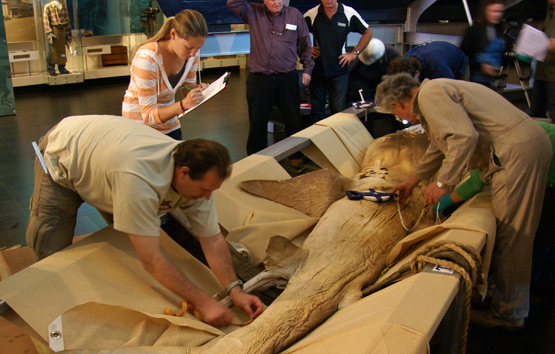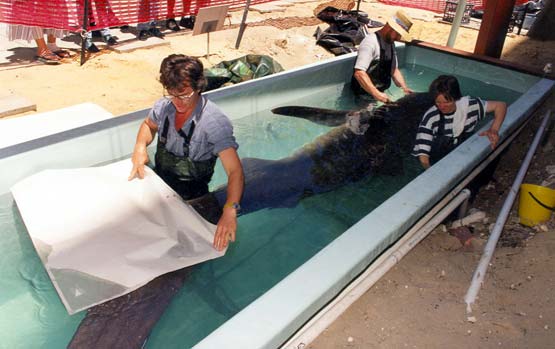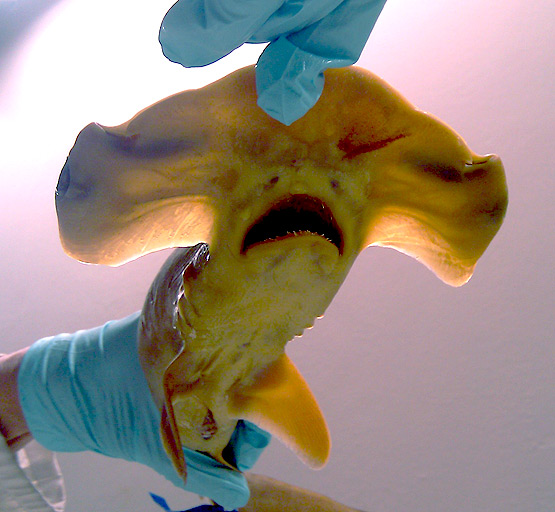Conservation Information
The following provides a context and history to the preservation of Megamouth (III), from early preservation with formaldehyde, to when it was decided to change the preservation medium into ethanol.
This finishes with the decision to move Megamouth from alcohol to 65% glycerol, and so it can be safely displayed and improve his preservation.

- Measuring Megamouth
- Photo by Andrew Rowe, WA Museum
- Photo copyright of WA Museum
Preservation of Megamouth III with formaldehyde
The use of formaldehyde (HCHO or H2CO) in the preservation of organic tissue has been documented since 1893.
When formaldehyde dissolves in water it forms the highly reactive methylene glycol. This chemical is rapidly diffuses into tissue of the specimen.
H2C=O + H2O → CH2(OH)2
As Megamouth III was so rare and largely cartilaginous in nature, the decision was made to directly inject the body cavity with needles filled with formaldehyde (traditional preservation methods involve dissecting and reassembling the specimen, while treating parts of the animal individually).
About 40 litres of the chemical was pumped into the body before it was placed in a treatment tank. Several incisions were made in the soft underbelly of the animal before it was placed in the solution for eight weeks in the treatment tank. These cuts will were designed to assist allowing the formaldehyde to diffuse through the skin.
The ‘tank’ was constructed at the museum’s off-site collection store in East Fremantle. The pool had two liners to stop the formaldehyde leaching into the active groundwater table, and no contamination of the area was detected at the end of the project.
Modelling removal of formaldehyde
As formaldehyde is highly dangerous and carcinogenic, it was decided to preserve Megamouth in ethanol. To do this, modelling activities to remove the chemical were devised.
The normal amount of time taken to remove formaldehyde varies from a few minutes for small fish to one or two days of rinsing for very large specimens. However, the majority of such processes are controlled by diffusion; therefore there was some doubt about the efficiency of previously established washing regimes in removing the formaldehyde.
It was found that if traditional methods were used, this would result in toxic storage solutions that couldn’t be safely exhibited. In order to develop the best way to release formaldehyde from preserved sharks, an old specimen stored in the worst solution environment would be used as a testing model.
Washing the Shark Hemigaleus Microstoma

- Washing the shark Hemigaleus Mircostroma
- Photo by WA Museum
- Photo copyright of WA Museum
The testing model selected as a 4.4kg shark, Hemigaleus Microstoma. The shark was placed in an 80L washing tub of deionised water and the treatment was followed for 27 days until the formaldehyde levels reached a plateau.
There was little contamination of the shark with adventitious formaldehyde and the preservative was being removed from the animal itself. The most important aspect of the experiment was that the release of formaldehyde (during washing) was not linear but instead a logarithmic function of time.
Comparisons of the efficiency of water and ethanol in regards to removing formaldehyde from muscle tissue found that water was just as efficient at removing the substance as ethanol.
During the 27 day experiment, a total of 150.4g of formaldehyde was extracted from the specimen. Initially, 4 wt% formaldehyde solution was used to fix the specimen, and 3.58 wt% was subsequently removed.
Despite these positive results, further research was required to determine how much residual formaldehyde is needed to ensure the specimen does not decay in the ethanol, in order to decrease the exposure of staff to the toxic substances.
Washing of Megamouth III
Based on the results from the test shark, in 1994 it was decided to wash Megamouth and remove the formaldehyde. Megamouth’s tank was filled with tap water and the shark was washed from 30 November 1994 to 3 January 1995. Megamouth was removed at this relatively early stage for fear a loss of too much formaldehyde would make it less stable in the ethanol.
The small test shark had a zero formaldehyde concentration at two hours, while Megamouth required seven hours of washing due to its size. Despite such large differences in sizes, the sharks had similar formaldehyde release rates.
Exhibition of Megamouth III

- Megamouth preparation
- Photo by WA Museum
- Photo copyright of WA Museum
In order for the specimen to be safely viewed by the public, a custom-made fibreglass tank was supplied and located between the Old Gaol and the main exhibition building.
Cotton wool swabs were placed in a detachable PVC pipe leading into the main filter capture the fat globules that are released over time from large marine specimens. Beneath this ‘oil filter’ 25kg of carbon was installed to remove the yellow-coloured materials which develop in large sharks and fish stored in aqueous ethanol solutions.
Megamouth was then placed 316 stainless steel supports inside the tank. Once these supports were mounted, several thousands of litres of water was removed and a glass cover was used to sealed the top of the tank. The tank was now prepared for the delivery of 7,000 litres of pure ethanol.
The ethanol was delivered to the Museum in the evening of the 25th of January 1995, since safety precautions required the work be done out of hours. Pumps were used that kept the incoming ethanol fully mixed with the existing volume of water, reducing the risk involved in moving the shark directly from water into 70% ethanol.
For the first six months of its exhibition, the plumbing worked well and the solution was clear. However, there was some concern that the storage container may shatter the glass as rising temperatures caused ethanol to expand (an increase in 10 degrees causes a volume expansion of 87L for the 10,000L storage tank).
Two years later (in 1997) the solution level in the tank seemed to be falling, so the purification facility was shut down. It was discovered that aqueous ethanol had leaked into the fibre-optic lighting system. Subsequently, this was removed and solution levels were topped up through a hole that was cut in the glass to allow gases to escape during the initial filling operation. This returned the Megamouth’s storage to an equilibrium.
Moving Megamouth into glycerol
After almost 15 years of storage in 70% ethanol, Megamouth had to move from his storage tank. Two major reasons determined this: the nearby Francis Street building was to be demolished and 7000L of highly explosive liquid could not be adjacent to this area; Megamouth had begun to deteriorate in the 70% ethanol solution.
Dr Ian McLeod determined that storing Megamouth in a 65% glycerol solution would not only be a more stable, less hazardous material, it would also improve the shark’s appearance.

- Reef shark 60% vol June 2010
- Photo by WA Museum
- Photo copyright of WA Museum
Over a six month period, tests were performed on a reef shark and a hammerhead shark that had been preserved in 70% ethanol and were moved into 65% glycerol. In this test sharks, their appearance had significantly improved, and the ethanol had been displaced by glycerol.
It was now time to utilise this technique on Megamouth.

- Hammerhead teeth 65% glycerol
- Photo by WA Museum
- Photo copyright of WA Museum
The conservation of our megamouth
- The use of formaldehyde for preservation has been documented since 1893.
- When formaldehyde dissolves in water it forms the highly reactive methylene glycol.
- Formaldehyde is able to rapidly diffuse into organic tissue.
- About 40 litres of the chemical was pumped directly into Megamouth’s body, rather than dismantling it, before it was placed in a treatment tank.
- There came a desire to remove the chemical from the shark due to its ‘shrinking’ effect on the specimen.
- Removing formaldehyde from Megamouth III was achieved by washing the shark for more than a month in a storage tank.